It is very difficult for any novice fisherman to navigate the tackle market - huge selection fishing rods and spinning rods, all kinds of accessories and fishing line, not to mention the reels, which have a large difference in price and characteristics. To somehow help novice fishermen, this article was created. The focus is on inertia and inertialess coils, the difference between them and recommendations that will certainly come in handy before buying any beginner.
accessible and understandable
Between themselves, the inertial reels differ from the inertialess reels by dropping the fishing line in the process of throwing gear. Usual physics - either the fishing line is dropped from a fixed reel, or the reel scrolls by inertia towards the tension of the fishing line, providing an opportunity to reset. There are millions of disputes around these two types of coils, which last for several decades and still do not subside. The reader is given the opportunity to decide for himself which coil he needs to purchase, because in the market inertial and inertialess devices divide the market equally, and none of the types is going to retire.
A little about inertia
In its appearance, an ordinary inertial reel is more like a reel with a fishing line wound around it, however, upon closer inspection, you can find that the inner edges of the reel are perfectly polished. The fact is that when the line is quickly dropped and rewound on the reel, there is constant friction between dynamic and static objects.
An inertial reel requires the use of a heavy bait or sinker, otherwise it will not be possible to cast the tackle over a long distance. After all, in the process of casting, the load, trying to drag along the line, collides with the resistance of the reel, which decreases as the line is pulled out. When the bait reaches its destination on the water, the tension of the line decreases, and the reel continues to give the line by inertia.
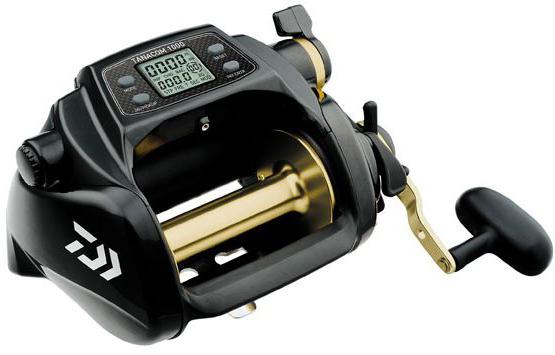
Expensive and complex mechanism
Inertial reels for fishing rods have a direct competitor - inertialess devices, which are popularly called "meat grinders". This name is quite understandable, and it's not even a matter of visual similarity. The principle of operation of such a coil is based on a worm or crank-and-rod transmission of rotation. Visually, the process of actively dropping and winding the fishing line seems quite simple, but there are many difficulties that arise when servicing the mechanism - not everyone can assemble and disassemble the inertialess reel at home. And given that maintenance is recommended after each use, many avid fishermen have no desire to purchase an expensive device.
fly reel
For fly fishing, when light bait is used, sometimes even live (fly, dragonfly), a fly reel is used. This is an ordinary inertial spinning reel, except perhaps large sizes. Such a reel practically does not participate in the casting, since the tackle is thrown by the whip method (with spinning around its own axis), and is etched by the usual course of the reservoir. However, an indispensable component of an inertial fly reel is a ratchet or draft regulator, which prevents the reel from spinning quickly.
The winding speed of the fishing line directly depends on the diameter of the reel, the larger it is, the slower the rotation by inertia occurs. Naturally, it is easier to reel in a bait or a caught fish to the shore with such a reel. But fishermen try to choose devices that are smaller and lighter, because fly fishing very often drags on for more than one hour, and it is very difficult to hold a spinning rod with a large reel in your hands.

A worthy offer of a domestic manufacturer
The inertial reel "Nelma" for fly fishing has been known to many fishermen for decades. It's not in vain about her performance characteristics and the tricks of catching were removed documentary with the same name. It is clear that after the film was shown on television, the Nelma coil found many fans.
The mechanism of the popular coil is compared with the revolver of the Nagant system - just as simple and trouble-free. The size of the famous Russian designer Vasily Pilipchuk was not chosen by chance. The outer diameter of the drum is 114mm and the inner diameter is 90mm, the result of many years of experimentation and research. Perfectly matched dimensions made it possible to create a light, durable and very comfortable device.
A legacy classic
The inertial reel "Nevskaya" is better known among the older generation of anglers, because its heyday is considered to be the middle of the last century. On the reservoirs you can often meet fishermen with this legendary reel. What attracts people to this dilapidated-looking device? Light weight, simplicity and reliability, a huge resource of work and the possibility of constant modernization, low price and adaptability to any weather conditions- this is only part of the positive characteristics that can be found in the media.

Interestingly, some publishers of fishing magazines have again raised the issue of quality tackle on Russian market. It turns out that many low-cost devices made outside the Great Wall of China are very Low quality. All the recommendations of professionals come down to one thing - those who want to save money on buying gear without goods domestic production not enough.
Usability
Inertial coils can be not only for left-handers and right-handers. If you delve into the functionality that is presented on the market, then the user will find a lot of interesting things for himself. It is very good if the reel is equipped with a mechanism for tighter line laying. In fact, more line will fit on the same spool if the smart mechanism winds it evenly. Those wishing to save on purchase to achieve the same result will have to use the index finger as a mechanism, making the same movements that an expensive device does.
If the inertial reel is equipped with a braking system, you should pay attention to the thickness of the fishing line when buying. Most manufacturers indicate the maximum diameter on the reel body, you do not need to exceed it. After all, braking is ineffective, and a thick fishing line simply destroys the mechanism.

Wonder cartoon
No need to think that inertial fishing reels, along with cheapness, have a depressing appearance and they will draw all the strength out of the fisherman, who will reel in the fishing line that has been exhausted for a hundred meters. Technology does not stand still, and along with inertial devices equipped with complex mechanisms, fans of inertial equipment will find a worthy reel from multipliers.
Inertial reels with a large number of bearings and a gear ratio between the handle and drum mechanism are far from an innovation in the fishing world, especially when it comes to multipliers. Naturally, the more functions in the coil, the higher the price of the device and the more complicated the mechanism, however, these coils do not have fewer fans.
You need to be very careful when choosing a gear ratio for a reel. It is clear that the larger it is, the faster the line is reeled. Only the buyer for some reason forgets that the increased frequency of the spool leads to rapid wear. Or you need to pay attention quality service mechanism, or give preference to a smaller gear.
Briefly about the differences between multipliers
First of all, the division is between classics and trolling. classic device barrel type is designed for casting heavy lures (25-100 grams). But for trolling, including sea reels, multipliers with counters are used. There are about 50% of such devices on the market, and they are a novelty for many novice anglers. There is nothing terrible in this, the counter is designed to mark the fishing line when lowering the wobbler to the desired depth.
The price of devices is highly dependent on the material of the body and clutch. Plastic, aluminum or titanium - the buyer decides, the main thing is to always remember that the increase in price is proportional to the increase in durability.
A lot of talk about the braking system in multipliers. Such inertial reels for fishing rods have the following types brake system: magnetic, mechanical, centrifugal. A novice angler will not feel much difference until he tries each species separately, so there is no point in specifics.
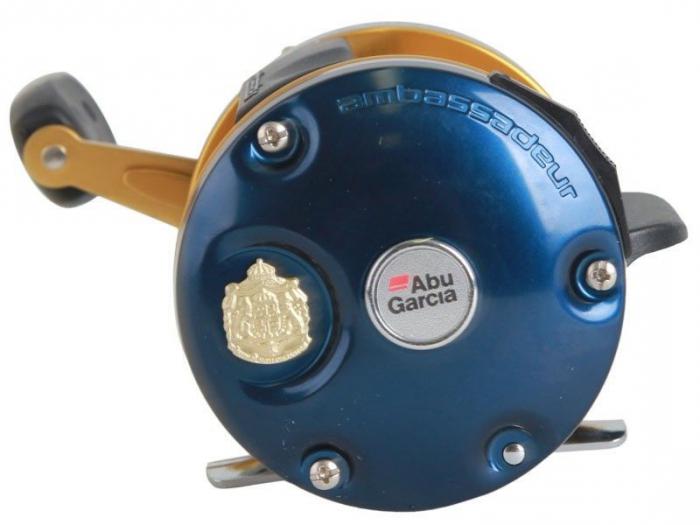
Which multiplier do you prefer?
The principle of choosing reels, like other gear, is unique for any fisherman and is unlikely to suit everyone. The choice can be made by price, quality, weight, ease of maintenance, fishing method, and so on. However, if you follow new trend and give preference to a well-established brand in the market, you can heed the advice of professionals who have left their reviews in the media.
- Shimano. The number one brand in the world for the production of not only bicycle parts. For the Japanese giant, inertial fishing reels are the engine of trade. According to statistics, Shimano devices are more durable than competitors.
- Daiwa. An inexpensive solution from Japanese engineers first of all flooded the market with many modifications. Every fisherman, from amateur to professional, will always find the right device.
- Abu Garcia. Legendary inertial spinning reel "Ambassador" developed by Swedish concern, is still in demand not only among anglers, but also among collectors. A reliable tool in the hands of a professional.
Question - answer: winding fishing line
The question “how to wind a fishing line on an inertial reel” remains relevant among beginner fishermen. At first, the process seems quite simple, because, unlike inertialess devices, the straight-line mechanism does not twist the fishing line. But because of this straightness, there is a problem with a knot that constantly scrolls, especially if braid is used instead of fishing line.
Everything is very simple: you need to wind a braid or a layer of thin fabric on the spool in one layer. Having made a loop and passing the main fishing line through it, you need to tighten the knot over the wound fabric. Holding the knot with your finger, make a couple of turns of fishing line around the spool. Remove your finger and gently, tightly wind evenly a couple of dozen turns. After that, putting the reel with fishing line on a pencil and holding the mechanism between your knees, you can start winding the fishing line on an inertial reel.
Many fishermen, trying to wind the fishing line on the reel, use a book as a tensioner. This method is quite popular among owners of inertialess devices - the book does not allow the fishing line to get tangled or twisted. For this method a large-sized book is suitable: a telephone directory, an encyclopedia, a volume of Lenin. The main thing is that the book does not open spontaneously as a result of stretching the fishing line.
Question - answer: casting gear
The question “how to cast an inertial reel” will bring a smile to the face of any angler, because in fact the tackle is cast with bait. But this process is quite complicated when compared with the same inertialess device. Oddly enough, it's about inertia, which needs to be slowed down and stopped in right moment, otherwise the fishing time will be spent unwinding the “beard” of a tangled fishing line.

You can't do without training - professionals recommend studying the principle of operation of an inertial coil using the pendulum method of casting gear. Taking the spinning rod in one hand, and the tackle in the other, you need to release the fishing line so that the handle of the fishing rod is at waist level, and the tackle is at knee level. Having unlocked the reel, and lifting the rod, it is necessary to make a pendulum movement forward, dragging the tackle in the same direction. When the tackle touches the water, smoothly put the reel drum on the brake. Having learned to control the drop of the fishing line in this way, you can move on to fly casts.
What not to do for beginner anglers
In the market, an inertial spinning reel is very often offered by the seller as a complete assembly. It is clear that such a solution greatly facilitates the efforts of a beginner in choosing all the components separately, and also saves a lot of time on rewinding the line and tying knots. However, more often the seller collects a set of goods that have long been stale on his shelves or have some kind of marriage. In the media, many professionals recommend paying more for individual components than buying a "pig in a poke", because it will be difficult for a person who is unfamiliar with gear to navigate and find a marriage on their own. visual inspection components.
This recommendation also applies to those who like to buy second-hand goods via the Internet. Even an almost new inertial coil, the photo of which will be impeccable at first glance, can have many minor damage ranging from broken bearings caused by a fall to normal rust internal mechanism.
Finally
As you can see from the review, the inertial reel is a perfectly acceptable tool for any type of fishing. Yes, there are some difficulties, for example, during training to cast long distances, but this is the usual training that millions of people go through before gaining the coveted experience. But, having learned to cast tackle using a conventional inertial reel, there will never be problems with casting other gear, because they are all much simpler. Equivalent to learning to drive a car with mechanical box transfers - transfer to the automatic machine is easy and simple!
Novice spinningists often ask the question - how does a multiplier reel differ from a spinning reel, and in general, what is it?
We warn you right away: an inexperienced angler should not start with this type of reel, this is still a tackle for professionals or at least experienced spinningists. But it is, of course, necessary to know the features of its application in order to see what to strive for.
The evolution of fishing reels
In spinning fishing, there are 3 types of them:
- inertial; these reels appeared as tackle before the rest and are still being used with success; they are distinguished by their simple design using a rotating drum equipped with a ratchet brake;
- inertialess; here the fishing line is simply gradually removed from the spool without any rotation, and, therefore, the inertia created by the bait during long-distance casting; for a long time was considered a revolutionary method of spinning fishing;
- multiplier; it is curious that, in essence, this is a return to inertial coils, only in a more complex version; it turned out like a development in a spiral.
Spinning reel or multiplier
Today, this question is faced by many anglers and does not contain a clear answer. Each of these types of coils has its own advantages. In inertialess gear they are:
- ease of casting, the skill is acquired very quickly;
- the line rarely forms a "beard" even with a long cast
- light weight;
- speed of winding, for one turn of the handle you can wind up to 1 m of fishing line;
- friction brake sensitivity.
The multiplier reel has its advantages:
- casting with its help is also simple;
- such a reel is good when using heavy bait;
- allows you to use thick fishing line;
- fishing in this way is less energy-intensive.
Which coil is better
A few years ago, the owners of multiplier reels seemed almost like aliens, and this tackle itself was not quite a familiar curiosity, fun for eccentrics. Now it is no longer a secret that this type of coils, in essence, - modified winch.
To understand which coil is better - multiplier or inertialess, you just need to check them out, on a certain body of water and when catching specific fish species.
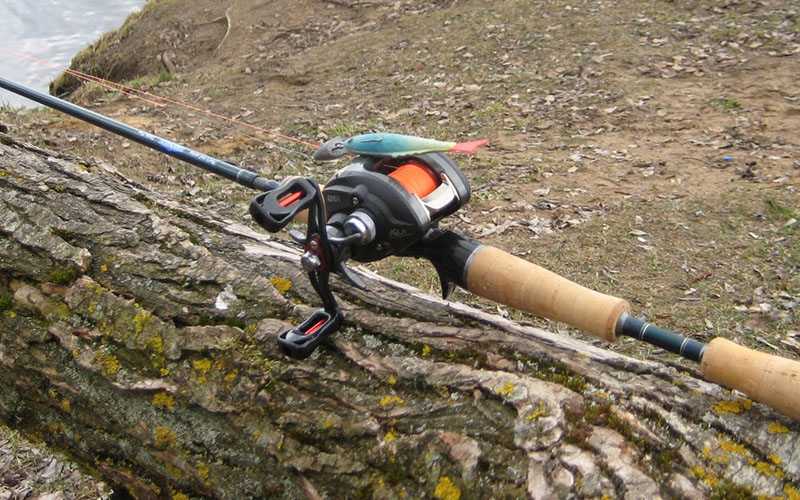
Let's say if you're going for big prey, "mults" give a sense of confidence because of the reliability and simplicity of design. It is believed that this the coil withstands more serious loads. In this case, the problem - multiplier coil or inertialess - is solved in favor of the first.
However with baits weighing less than 5 grams, handling "mults" is not very convenient, besides, many tackle seems unnecessarily cumbersome.
When deciding what is better - multiplier or spinning reel, - many fishermen pay attention to regulated system brakes in "winch" designs. It seems to work well and reliably, but it has to be adjusted for each type of bait or fish. Not everyone enjoys fishing.
New generation tackle reels are lighter. But inertialess is easier to use. Multipliers after casting have to be shifted from hand to hand, especially if you are right-handed.
Is the "cartoon" suitable for ordinary spinning
Another difference between a spinning reel and a multiplier reel is in use different types spinning. That is, the usual tackle for the "cartoon" is unsuitable - there are too many rings on such a spinning rod for it. You either have to redo it (which, in principle, will not help much), or buy a special casting spinning rod. It will turn out a little more expensive, but such tackle will surely last several seasons.
Useful video
Let's look at the video for an expert opinion on the differences between a multiplier coil and a spinning coil:
Summing up this analysis of different types of coils, we can say that the choice here is up to everyone. Both gear can be used for casting, and for trolling, fishing from a boat. Both require skill and skill.
This article will containfinalizationon some "jambs" inspinning reels, and a review of two models. The improvements presented also apply to other reels that require it. Since I received 3 spinning reels from the store for revision, 2 ELF (2500s and 2500) and NASCI 2500. But later the NASCI owner was afraid that the reel would become worse after refinement, expressed a desire to pick up this device, saying that, since it was done, it means that it should be so. I did not dissuade him. And as a result, 2 elves remained for the “servants”, so the article will be a review of one coil model (team, since the coils are paired).
And so, let's start, or, as Gagarin said, let's go!
The reel on the move turned out to be very pleasant. What could not be said about backlash. It immediately caught my eye that the coil had a strong longitudinal play of the rotor, which was even very noticeable when the reverse stop was turned on, when the handle stopped rotating, the rotor rose by 2-3 millimeters, which is very bad, just technically, and was also accompanied by discomfort during intermittent rotation. In most coils, this indicates a poor fit of the parts seats, but in this case it turned out that the bearing was not pressed against the body by overrunning, and as a result, it dangled freely, which resulted in such a backlash. Having unscrewed the overrunning, I found two washers placed for some reason only under 2 overrunning screws. Here are the pucks.

Photo 1
Why they were there was not entirely clear, however, having measured all the components, and found that their absence does not affect the centering of the clip in height, we remove them and fasten the trim into place. Thus, the backlash disappeared, remained very small, barely noticeable, due only to the quality of the bearing itself.
The backlash of the main pair was chosen by selecting the washer of the desired thickness.
Here it is impossible not to say that, the one who does not pay attention to this, runs the risk of breaking the teeth of the drive gear at some point. Since with such backlashes engagement of the teeth best case goes to the floor of the tooth, and not for the whole, as it should be, and the running-in also goes by half, because under load the gears “disperse” due to the fact that the tooth basically has a trapezoid along the profile. For this reason, the choice of backlash must be made immediately, and not after, for example, a year of operation, after some time, removing the backlash, the coil can growl radically, and nothing can be done about it.
Also, in some reels with an endless, and in all with a backstage, there is a belt on the main gear. It was made not just like that, but under it in without fail a gasket should be placed that does not allow the main gear under load (when we turn the reel handle) “bite” into the rotor gear, so the load on the teeth becomes uniform and constant, regardless of whether the reel is under load or not and the engagement will be at the same level Why the manufacturer does not do this is not clear.
![]()
Photo 2
The transverse play of the rotor gear was eliminated by lining the fluoroplastic film around the bushing, the bushing was planted tightly, but without deformation, we will not get it in the future, because lapping of the main pair will already take this into account.

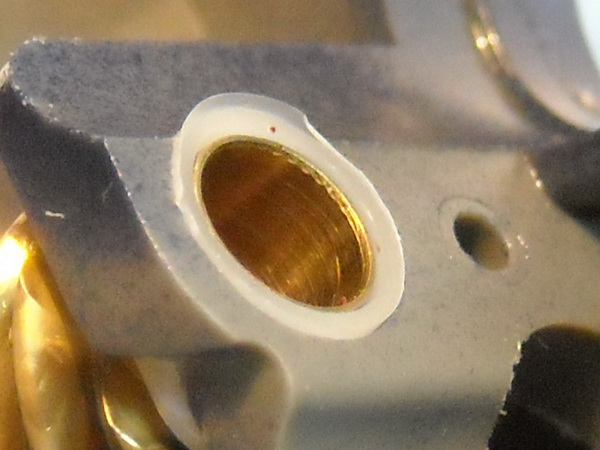
The longitudinal play of the rod from 3 mm is reduced to 1 in the same way that was described in the 1st part of the article.
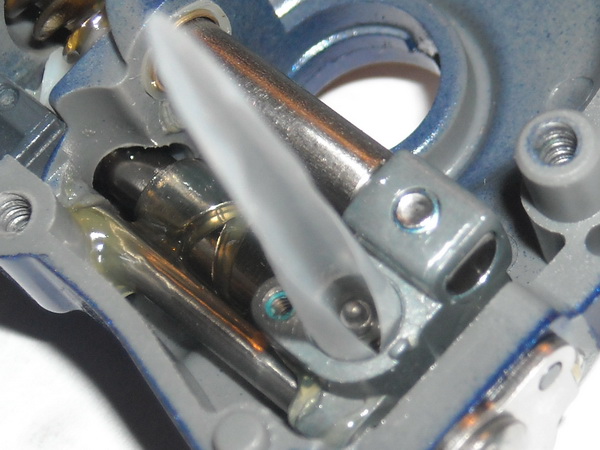
Photo 5
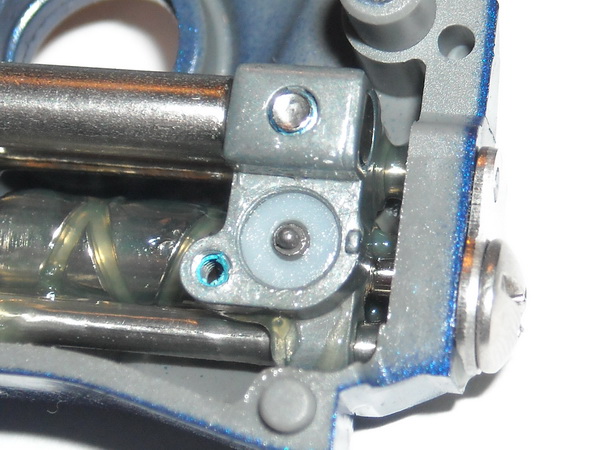
Photo 6
There is no shank around the rod axis, since the carriage is located on two guides, which exclude this phenomenon. The movement is smooth in both directions, there is no biting, which indicates a good alignment of the axes of the guide mechanism and precise processing of surfaces, both internal and external. ABOUT longitudinal play the manufacturer himself has already taken care of the infinity here, putting it with washers, tutelka in tutelka.
The roller does not need to be finalized, since the play is negligible, the rotation is very good, and the design itself is quite well thought out.
Also, those who have the opportunity to make a new roller on the ball can give themselves pleasure, make their coil even better. I cut according to my size and not from the original. Expanded the groove, the partition in the middle - so that the bearings rotate independently of each other. Completely satisfied with the result, got what I wanted. It's not that hard to make it.
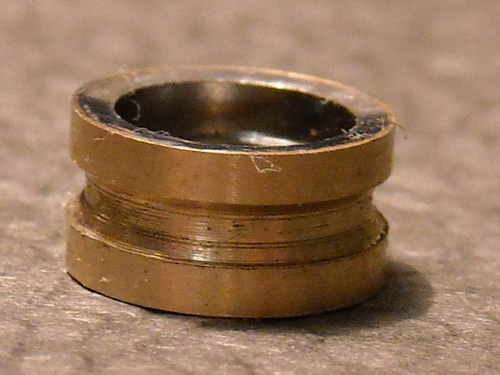
Photo 7

Photo 8

Photo 9
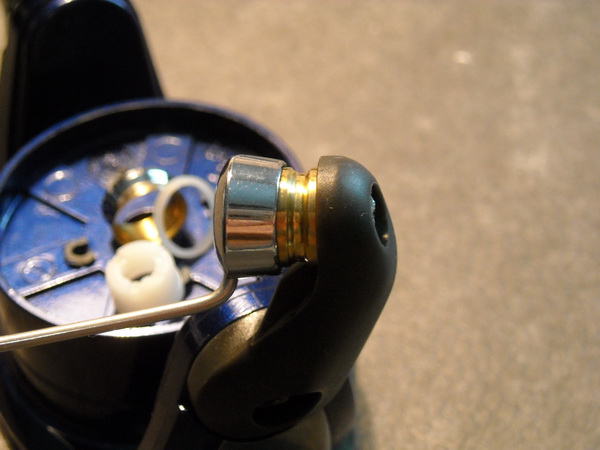
Photo 10

Photo 11
Since the processing was not carried out on special equipment, then naturally the video has a slightly noticeable imbalance. But at the same time, if you spin it with a piece of paper, then the rotation lasts a little more than 9 seconds (of course, without lubrication), I haven’t seen this in any coil yet. backlash not with washers, but with the help of a groove that is inside the roller. Between the bearings, the copper washers are 0.05 wider than the grooves so that the bearings do not tighten when twisted. Thus, the roller is centered between the two bearings, as originally intended. The groove is made wider by a specialist in order to sometimes use flat cords. And that's why she's in the middle of the video. I made the shape simply - a trapezoid on the sides, a small fillet in the recess, with such a profile, any cords and fishing lines are already. And then most of the factory rollers have a small groove, and the shape of the groove is acute-angled, some fishing lines and flat cords bite. I also had to remove the imbalance of the rotor that appeared.

Photo 12
It is also desirable to carry out the prevention of the roller after 2-3 fishing trips.
For reels whose roller design is similar to that of the DAIWA laguna type, it is possible and necessary to put a thin gasket under the bearing from the side of the screw, of such thickness that when the screw is fully tightened, this does not affect the rotation of the roller, and the diameter between the inner and outer races of the bearing . If this is not done, then when the screw is tightened to the limit, the roller will clamp and it will not rotate.
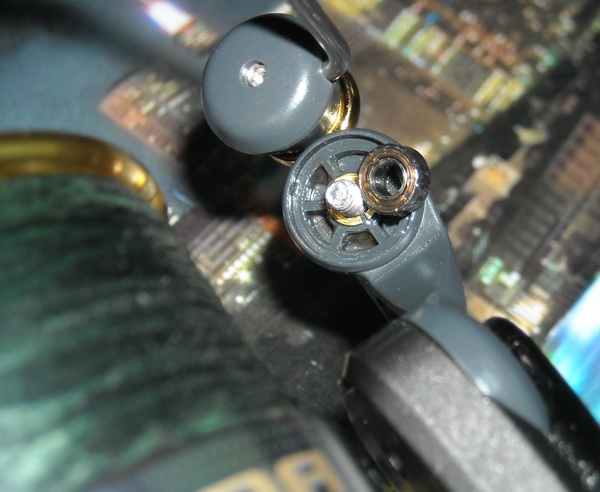
talking about lubricants you can give such advice that if the grease is too thick, then you can dilute it to the desired consistency with oil for the coils (just keep in mind that not all lubricants allow this, also for a while the diluted grease falls on some kind of plate, and if the oil does not out, then everything is fine).
For some coils (if not for all), it is possible to facilitate the discharge of the bail by bending the arc, to the point where, being at rest, the bail is already adjacent to the "ear" of the rotor. In this way, we will avoid erasing the "ear" and body in some places, and the easier movement of the bail, due to the very small resistance from the counterweight.

Photo 14
In the photo, the ear is not screwed, but it is already clear that there will be no problems, there is no skew. Having sharpened a little the ledge into which the bolt is screwed, we will reduce the chatter to almost zero.

Photo 15

Photo 16
For example, even a photograph in a magazine already shows an obvious flaw.
 Photo 17
Photo 17
 Photo 18
Photo 18
The bending and ear of the roller will also become the smallest, because when twisting the bow, it bursts the ears, and by bringing it into the desired bend, we also prolong the life of the seats of the line laying bow.
Having removed the rotor, I see a lubricant on the ring, which to the touch is more like a paste. In the rotor itself, the lubricant looks and feels in the normal state and in enough. So I left everything as it is.

Photo 19
I remove the gear and see what it is almost dry!
![]()
Photo 20
The mechanism itself is also practically lubrication-free. More precisely, there is grease, but ... not there.
The bushing is completely dry!

Photo 21
And if inside the rotor and on the retaining ring there is a white-whitish grease, then this one cannot even be called a grease, it feels like old wax to the touch, but I don’t even want to talk about color.

Photo 22
![]()
Photo 23
Lubrication seems to be normal on the bushings of the infinity, but still the whole mechanism was thoroughly washed 2 times, lubricated with new grease.
And now look at the rotor gear, a black coating is exactly where the grease residue was.
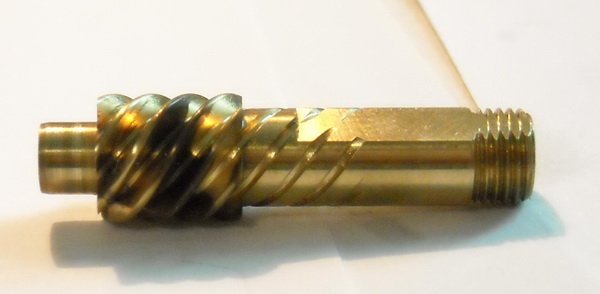
Photo 24
And the washer pressed against the bearing also darkened.

Photo 25
Even on the recently popular daily-fishing site, some gears show this effect.
From this it follows that the lubricant has lost its properties for the worse during the storage of the coil.
I will answer this THIS IS TOTAL BULLSHIT!!!
No one can say specifically and definitely what this entire service life is, it can be a year or two or five. Even from a technical point of view, the bearings hold the entire load, and need more care, since the coil stroke will immediately decline, as a result, non-care will lead to severe loss quality.
I'm sure most (if not all) don't know that the lubricant put into the coil at the enterprise has a resource of about 1 year, depending on the operating conditions and intensity. And all the statements that I haven’t smeared the coil for 5 years and everything is normal there is complete nonsense, that person would try not to service his car for 5 years., And then he would say such a thing.

Photo 26
We wash well, I usually do this with balls 3 times.

Photo 27
Fill with new grease and close.
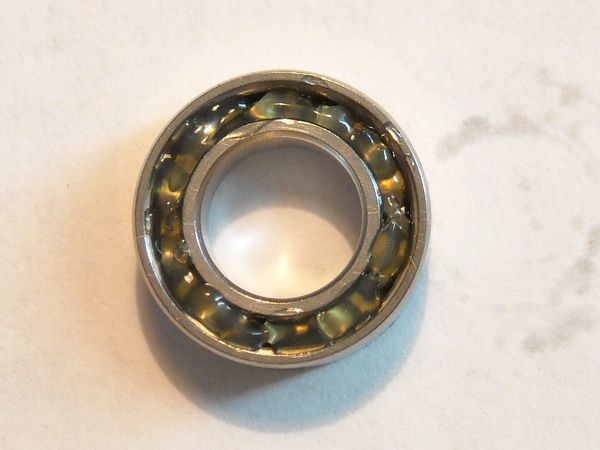
Photo 28
All bearings were dry, as well as infinity bushings inside.
Here's some food for thought is it worth it to use the reel you bought right away ???
The mechanism is killed at once, and cannot be restored.
And then they say the reel has worked for several fishing trips and the course has changed, and it doesn’t seem so good itself anymore, and in general it’s not a reel, but complete rubbish, etc. - think about it well.
I conducted a small experiment with a friend, in ryobi exia 4000, instead of standard balls, they put new Shimanov ones, 3 main ones, the coil stroke changed by several orders of magnitude, but for these coils it is too bold, so the new balls were delivered to their homeland, but the fact of lousy balls in the ruobi coils was obvious. However, if the shiman is done with such bells and whistles, it will cost a lot of money, in principle, which is what it really is. But who has unnecessary balls from shimano lying around (although it’s unlikely) - put it in, you won’t regret it.
By the way, when I opened the lid, reverse side the gasket stuck on the lid, the one in the photo, only by a miracle it didn’t get into the mechanism, and where it came from, it’s not clear (how it got there, too). Also, don’t forget mark the gears, be sure, also in multiplier coils, this is also a very necessary operation, because. when the spool is turned off, the gear only moves to the side, and the pairing of the gears remains the same.

Photo 29
When flushing the clutch nut, this was found in the sediment.

Photo 30
It is also desirable to remove this burr, since, having fallen off, it will fall into the spring, or somewhere else and it will be possible to interfere with the normal operation of the mechanism.

Photo 31
If, during fishing, this shaving from the handle hit the ball, then it would be tryndets bearing, there is less chance of getting into a closed ball, but no one has yet canceled the law of meanness, and even more so into an open bearing.

Photo 32
Also, in order to remove the backlash of the 4-hedron, the pin was carefully knocked out, and under it, with an interference fit, a copper plate was placed, after which the pin was put back. After that, it is very undesirable to fold the handle so as not to break the connection. The handle, together with the lid-nut, is carried separately, at first it is unusual, but then it is taken for granted, and does not bother.

photo 33
The backlash of the tetrahedron in the gear was eliminated by adding a thin copper strip, for the entire length of the gear, with a bend at the edges, so that it does not fall out when there is no handle (the thickness is determined empirically, the width is slightly less than the edge). In the photo it is shorter, but when the season starts, it will be the right size.
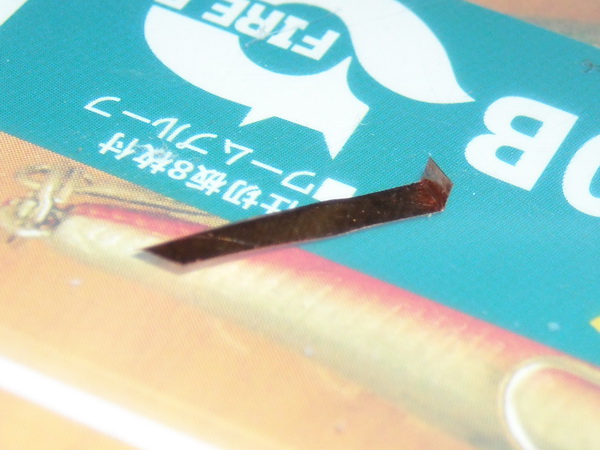
Photo 34
Also, the washer located on the cap was leveled with a hammer, and an ordinary flat washer of a slightly smaller diameter was placed on it. This is done so that with repeated puffs, the edges of the gear do not flare. And at the small plastic square-sleeve, the inner diameter was slightly drilled so that when clamping we felt the clamping force of the nut.

Photo 35
Backstop - Overrunning clutches have also been flushed and lubricated with new grease.
By the way, what I really like about Szyman reels is the clutch. In it, each roller is on an independent "suspension". And in ordinary ones, with a plastic separator, the rollers are very dependent on the total rotation of the separator, and are demanding on a very precise symmetry of the clutch cup .
ALSO in the reel, the bushing was replaced with a bearing that was under the spool, and a bearing was placed under the spool, which is slightly worse in quality than the native Shimanovsky. Thus, we have extended the life of the coil, and improved the performance of the mechanism.

Photo 36
“The bushing prevents wear on one part, usually the seat in the housing, but does not prevent wear on the shaft at the point of contact. The friction force remains relatively high. In order for the assembly to work normally, the gap between the bushing and the shaft is already relatively large in production.
The combination through a ball bearing is devoid of this drawback. Naturally, if the bearing is of high quality and not too large gap because of low level production. cheapest bearings well-known manufacturers are made according to accuracy standards - ABEC in the USA, ISO - international, DIN in Germany. in ABEC-1 and ABEC-7 (the highest class used in coils), the tolerances for outer and inner diameters differ by only 0.003mm (0.005 for ABEC-7 and 0.008 for ABEC-1), and for diameters, geometry of balls and treadmills even less. For reasons of kinematics, temperature changes and elastic deformation under load during production, the necessary and sufficient radial clearance is laid here, typical - 0.01-0.02 mm. This is very small compared to the tolerances for shafts and seats coil parts and, if there are complaints about the quality of the assembly, then the reason is at the coil factory, and not at the ball bearing.
A ball bearing assembly is more likely to fail than a bushing assembly: a ball bearing can “fall apart”, but a bushing almost never. When the wear of a pair-cage-balls is only a few hundredths, the ball bearing can already crumble. And the knot with the bushing seems to be alive, although the bushing has worn off a couple of dozen, and the axle has eaten through a couple of dozen. But can such a node be considered normally working? if it's a gear carrier? This means that in the gearbox the misalignment and gears, and all other parts associated with it, work and wear out in the wrong place and in the wrong way, backlash and shock loads progress.
At timely repair, i.e., first of all, the replacement of rubbing and wearing parts, the coil on ball bearings will last longer, and the repair itself is easier. First, although ball bearings are not always easy to get, they are still unified replacement elements. Secondly, they almost completely prevent wear of the shafts, i.e. prevent the need to replace them - and these are already unique parts that are not unified.
Extract from the special reference book.
Moreover, one should not be led by comrades who advise replacing the plastic bushing with a metal one (bronze, copper). Under no circumstances should this be done , since we are literally for fishing, or even less, we will kill the seats on the gears, and the resulting dust will kill the mechanism.
I will not go into the chemical composition and thermomechanical processing, and other necessary details. But you need to know the basic markings for bearing materials.
Here are those that are used in coils today:
CS-chrome steel-balls and cages made of bearing high carbon steel.
HC-hybrid ceramic-ceramic balls, and clips from SS
SS-stainless steel-stainless steel clips and CS balls
FC-full ceramic - ceramic balls and clips (the most expensive, the price for 1 unit reaches $ 150)
In multipliers, metal bushings are placed on a polished stainless steel axle, and it is preferable there than plastic, due to higher loads. And in inertialess gears are made of completely different materials, and have different properties.
Some reels have a too heavy spool, this is especially true for UL spinning. I drilled holes in 3 rows on one spool, also made a sample of metal from the inside of the spool, and drilled a series of holes on a smaller diameter of the spool, as in “soap dishes”. Thus, the mass of the spool decreased by 30%, which is already significant.

Thus, if the ul coil weighs 190g. then by reducing the weight of the spool, we can catch up with the actual weight up to 170g. Which is completely nonsensical. The cost of such a coil at the factory price would probably differ by half, but if you approach this correctly and know exactly where to choose the extra metal, you can not pay for it, but do it yourself, at home, without compromising functionality and strength characteristics.
At the same time, the functionality does not suffer at all, and so that water and dust do not get on the stem, then a thin plastic transparent ring must be inserted inside, the width of the spool skirt.
Having finished the coil in this way, we got a very good, high-quality and reliable tool that combines a good supply of power and durability in its field of application.
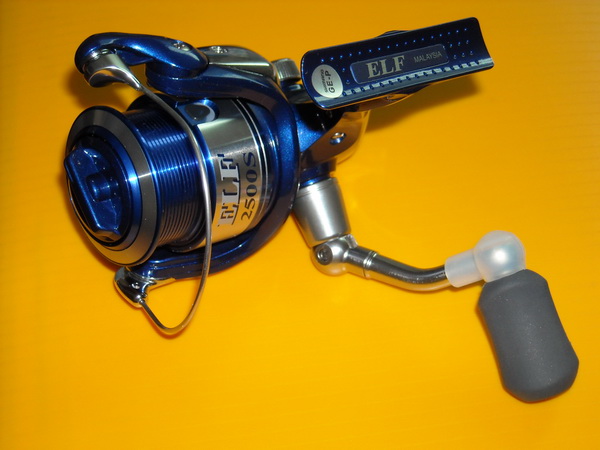
Photo 38
If a cheap coil is made very good, then no one will buy an expensive one, so those who are interested in not overpaying an extra amount can independently (with proper skills) bring an inexpensive coil to the highest class that can be achieved in this model. I specially went to the store and compared the rotor play in the STRADIC and TW FC coils. So they have rotor play MORE! , and this is not good, which is not permissible for such a sum.
Also, as I see from my statistics, the choice of reels for spinningists is divided into several groups:
For some, the indicator is a metal case, and an internal mechanism (reliability)
For others, a metal case - they don’t care about the insides at all
Still others choose by beauty (appearance) - imitating seagulls, throwing themselves at everything that glitters
4th - choose a compromise - hybrid body (half metal, the other graphite)
5-it doesn’t matter at all what it is made of, they don’t see the difference in coils for $20 and $200
6th - choose a valuable middle, price-quality ratio which unfortunately is happening less and less now.
The 7th is first of all evaluated, the thing is precisely on the quality of the internal mechanism, not paying attention to the discreet color and non-brand company.
8th-they like very expensive things, mainly so as not to "fall in the eyes" of their own kind, and twist their fingers in their team - the process of fishing itself for such people, with ruby rings and gilded spinning rods and reels, far, far, far in last place (if there is one at all).
Which group would you classify yourself as?
In conclusion, I would like to say:
Many people ask - why modify the coil ?! I will answer only one thing, that any modified, or, if you like, cured spinning reel, will live longer, the same standard. After all, finalizing your "lyalya" you know all of it weak and strong points.
These two parts of the article are a kind of template for upgrading your coils and testing your strength for this.
But each case of breakdown is individual and you can’t describe everything. Each detail needs its own approach and its own little secrets.
I like "poking around" in the coils, and I enjoy it. Also, seeing the expression on the faces of those who considered cheap reels to be crap, and then after catching one fishing trip with my reel (under my supervision, of course), they said that the reel is 3 times cheaper, and works several times better than its expensive brand, people simply, as they say, plus and minus did not converge, from the question - why is it so?
But they are the secrets, so that not everyone knows them, and only a few know the nuances.
Coil- an integral part of almost any sports fishing rod. A fishing rod equipped with a reel allows the angler to use thin lines for fishing fish, which, under the same conditions, is unthinkable to bring to a dead tackle.
The reel is necessary for spinning fishing, it is highly desirable for fly fishing, fishing from a boat, from dams and locks, as well as for winter ice fishing at medium and large depths.
However, not all anglers who want to purchase a reel are well versed in the variety of their models. In this article, we will try to deal with the issue of choosing a reel for fishing.
Spinning reels
The reel in the spinning holds large stock forests, allows you to make a distant cast of bait and helps to play large fish.
Types of spinning reels:
- with a rotating drum (bobbin, or inertial):
- ordinary;
- multipliers.
- inertialess.
Conventional inertial (spool) fishing reel
Inertial bobbin reels have a fairly simple design and are therefore cheap. Coils of this type with a drum diameter of less than 10 cm, they are mainly used to equip float or bottom fishing rods. A conventional inertial reel allows you to expend relatively little effort when pulling up large fish.
The main disadvantage of all inertial reels is the presence of a rotating drum, the inertia of which makes it difficult to effectively cast a light bait (weighing less than 10-15 g). When using relatively light baits, the line often gets tangled when casting, and it is also difficult to cast the bait against the wind.
The reels have a drum on a fixed axis that rotates when the line is fed during the casting of the bait, and, therefore, have inertia.
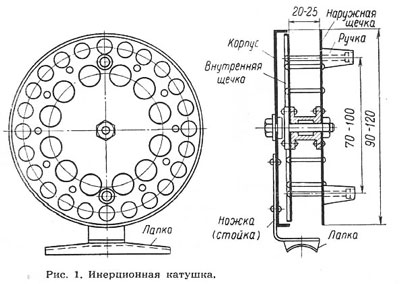 The general view of the inertial coil is shown in fig. 1. It consists of a body in the form of a round cover, in the center of which an axis is fixed, on which, by means of a bushing, a rotating drum (bobbin) with handles for winding the line is mounted. A stand (leg) with paws for attaching the reel to the rod is riveted to the body.
The general view of the inertial coil is shown in fig. 1. It consists of a body in the form of a round cover, in the center of which an axis is fixed, on which, by means of a bushing, a rotating drum (bobbin) with handles for winding the line is mounted. A stand (leg) with paws for attaching the reel to the rod is riveted to the body.
Requirements for the inertial coil:
- the outer diameter of the drum should be approximately 90-120 mm,
- line winding diameter - 70-100 mm,
- the width between the cheeks is 20-25 mm.
Coils of smaller diameters are unsuitable for fishing with spinning, as they do not provide the necessary speed for winding the line. The lighter the weight of the drum, the easier it moves, the less will be its inertia and the further the cast.
The weight of the drum is lightened by using a lighter but stronger metal (duralumin), reducing the thickness of the cheeks to 0.8 mm, drilling holes along the periphery of the cheeks; in this way, it is possible to bring the weight of the drum up to 50-80 g. The holes located closer to the center do little to reduce the inertia of the drum, but they must be made to create air (automatic) braking of the drum. In this case, the drum must be rigid and durable.
The handles of the drum should be light, of equal weight, removable, easy to grip with fingers, 18-20 mm long. It is better to place them closer to the center, but not closer than 30-35 mm from it. The axis of attachment of the handles must pass through both cheeks of the drum.
Most inertial reels have a non-adjustable ratchet brake, which is activated when transferring tackle and playing large fish. A deaf adjustable brake is used less frequently. To avoid entanglement of the line during casting, sometimes they make various devices for slowing down the drum, which are either pre-adjusted by hand or operate automatically. But these devices have a drawback - they reduce the casting distance.
To a conventional bobbin spool, regardless of how the system of rotation of its drum is structurally implemented (on ball bearings, on cones, on a cylindrical axis or on centers), the following requirements apply.
![]() The gaps between the rubbing parts of the coil should be as small as possible. The drum should have as little weight as possible for given dimensions, rotate easily and silently, be precisely balanced relative to the axis of rotation, and have neither axial nor radial runout. Both the casting distance of the bait and the durability of the reel itself depend on the accuracy of the manufacture of the drum and its weight. The reel drum must not have sharp edges. It is necessary that the reel be equipped with a ratchet brake or a silent friction brake and be easy to operate.
The gaps between the rubbing parts of the coil should be as small as possible. The drum should have as little weight as possible for given dimensions, rotate easily and silently, be precisely balanced relative to the axis of rotation, and have neither axial nor radial runout. Both the casting distance of the bait and the durability of the reel itself depend on the accuracy of the manufacture of the drum and its weight. The reel drum must not have sharp edges. It is necessary that the reel be equipped with a ratchet brake or a silent friction brake and be easy to operate.
When choosing a reel, it is advisable to pay attention to a solid-machined drum - it is usually stronger than a prefabricated drum, better balanced and more accurately manufactured.
The diameter of the drum is usually made in the range of 80-100 mm with a width between the cheeks of 20-23 mm and a height of 10-12.5 mm. This allows you to freely wind on the drum 100-120 m scaffolding with a diameter of 0.5 mm, and the scaffolding should not occupy more than half of the working volume of the drum. Its handles must have a height of at least 16 mm, a diameter of at least 8 mm. The design of the coil should allow for quick disassembly for cleaning and lubrication.
Comment
Most conventional reels do not have a special automatic reel brake. When casting, the angler slows them down with his finger. However, there are coils with automatic braking, the action of which is based on the use of pressure force of the line on a special lever associated with braking device coils. Such devices are not popular with anglers, as they “re-brake” the cast too much. Some reels are equipped with constant mechanical braking, with which you can pre-set the braking force of the reels depending on the weight of the bait.
Multiplier fishing reels
 Multiplier (or geared) fishing reels, unlike ordinary ones, have an incomparably smaller drum size, but due to the presence of gear gears, they are not inferior to ordinary ones, and often even surpass them in the winding speed of the line. One turn of the multiplier handle corresponds to 3-4 turns of its drum, which rotates in thrust bearings enclosed in fixed body disks.
Multiplier (or geared) fishing reels, unlike ordinary ones, have an incomparably smaller drum size, but due to the presence of gear gears, they are not inferior to ordinary ones, and often even surpass them in the winding speed of the line. One turn of the multiplier handle corresponds to 3-4 turns of its drum, which rotates in thrust bearings enclosed in fixed body disks.
Their drum is fixed motionless on an axis, the ends of which abut against two side cheeks mounted on a common base. The axis rotates in the end bearings, and with it the drum (bobbin). Shaft and handle connected gear train; with one turn of the handle, the drum makes 3-3.5 turns. This design allows you to reduce the dimensions of the coil, to make it extremely light undercarriage bobbin, for example, run it on the centers like a clockwork. The disadvantage of these reels is that the bobbin winding diameter is too small. At good coils the winding diameter is increased by increasing the cork; the handles turn off when casting, the bobbin axis stands on the watch stones; the reel is equipped with a line layer and two brakes: a deaf (adjustable) and a ratchet brake (unregulated). This reel allows you to make long casts, is light and easy to use.
Braking of the multiplier drum during casting is carried out with the thumb of the hand holding the rod, directly along the line laid on the drum. The ease of movement of the drum can be adjusted by pressing one of the two thrust bearings in such a way that it is possible to cast without braking with a finger.
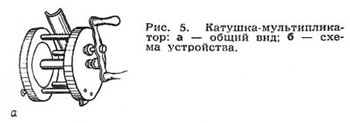
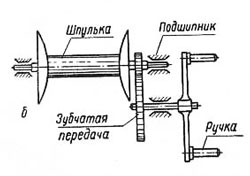 Some models of multipliers are equipped with a device that allows you to turn off the handles before casting in order to reduce the inertia of the drum. Multipliers equipped with a line stacker usually do not have a device for disabling the handles.
Some models of multipliers are equipped with a device that allows you to turn off the handles before casting in order to reduce the inertia of the drum. Multipliers equipped with a line stacker usually do not have a device for disabling the handles.
Multiplier coils differ in type of construction, size and, accordingly, purpose. It is customary to call a classic a simple, reliable and maintainable reel, having two disk cheeks connected by horizontal posts and a foot for the reel seat with screws.
Spinning coils
 Recently, the spinning reel has become widespread in the fishing world. Abroad, in a short time it has gained great popularity in all types of spinning fishing and has now replaced many bobbin reels.
Recently, the spinning reel has become widespread in the fishing world. Abroad, in a short time it has gained great popularity in all types of spinning fishing and has now replaced many bobbin reels.
The spinning reel is designed for fishing with very thin lines, which are not usually used with bobbin reels. Their main advantage is the ability to cast baits of any weight (even 1-2 g) with a minimum casting radius. For a medium-sized inertialess reel, it is recommended that woods be no thicker than 0.35 mm, which will allow you to fully reveal its advantages.
Compared to conventional spinning reels, all spinning reels are relatively heavy. In order to reduce it, designers are trying to make the dimensions of the spool more economical, which is calculated for a fishing line of only a certain thickness range. Therefore, the effectiveness of this type of reel depends to a large extent on the correct choice of line diameter and the correct filling of the spool.
Dropping the line when casting with a spinning reel is based on a completely different principle than with conventional bobbin ones. In contrast to them, the axis of its drum is parallel to the direction of departure of the line, and the drum does not rotate during casting. The line descends from it in a spiral through the outer cheek, so the weight of the reel has no effect on casting, since it does not interfere with the free flight of the bait, unlike conventional reels.
The amount of line running out of the drum during casting strictly corresponds to the speed of the flying bait, and as soon as the forward movement of the latter stops, the supply of the line automatically stops. The reel does not require any braking during the casting process - this is its first advantage. Its second advantage is that it allows long-range casting of very light baits, as well as the use of thin lines thanks to a device with which you can pre-set the desired maximum load for the line. Therefore, with skillful handling, the line cannot break when playing the fish, unless, of course, the fish takes the entire supply of line from the drum.
The reverse winding of the line is carried out by a special line laying machine (“pickup truck”), driven by the rotation of the reel handle.
Comment
For a spinning reel, you should choose a rod with low rigidity and equip it with guides of an incomparably larger diameter than for a conventional reel. So, for example, the diameter of the input ring of the rod should not be less than 35 mm.
The reel is placed on the rod in the lower position, its handle is twisted with the left hand. There are coils in which, if desired, you can rearrange the handle for rotation with your right hand.
Fly fishing reel
fly fishing reel can be attributed to conventional inertial coils. They differ in the presence of racks between the cheeks, which prevent the fly line from slipping transversely, as well as a drum fixed during casting. The fly fishing reel is also used for fishing in line and from ice. When fly fishing and in wiring, unlike spinning, the reel does not directly participate in casting the bait. Here its role is to give the angler the opportunity to change the working length of the line over a wide range when casting and playing fish.
The requirements for overlap coils are as follows. The reel should not be too light to help balance the rod with its weight. If you take a very light reel, it will not be possible to balance the rod with it, it will always be heavy-headed and tiring. The reel's forest capacity is determined by the characteristics of hunting: it must contain the main (working) cord and about 30-50 m of the backup cord. When large prey hits, then in order to bring it out, you must give it a move; it happens to throw out up to 30 m of the backup cord. The backup cord is called the lining. It is made from a cheaper material, but still quite durable. To wind all this, you will need a bobbin with a diameter of 60-70 mm with a width between the cheeks of 20-25 mm and a relatively thin hub.
Since the reel does not participate in the cast, it does not require ease of movement. On the contrary, brakes of two orders are needed:
- To regulate the cutting, designed for the load capacity of the leash. Let's say you have a leash that can withstand 200 g of dead weight, therefore, the brake resistance should be about 150 g. This reel has an indicator (calibrated) brake, with a wide range of action, which you adjust by feeling or by a small weight, turning it to one division or another . This ensures the integrity of the leash.
- Ratchet. After biting the fish, some pull it out on a deaf brake, others use a ratchet. Personally, I rarely use a ratchet and prefer to do the braking with my finger.
The material of the coils is very diverse, mainly aluminum alloys, occasionally wood, sometimes plastic. Plastic coils have to be loaded with lead to give some suitable weight.
Choosing a fishing reel
Usually coils are made of plastic or very light metal alloys. When choosing a coil, you need to pay attention to the following characteristics:
- capacity (determines the amount of cord to fit);
- winch type;
- braking system that helps with fighting;
- weight for balancing.
For fly fishing and wiring, you can successfully use the usual spinning reel medium or small sizes, as well as multipliers, however, they must be equipped with a ratchet brake, which must be constantly on when fishing. The weight of the fly-fishing reel and its location on the rod handle are selected in such a way that the center of gravity of all collected tackle lies on the rod handle at the point where it is gripped by the casting hand. The lighter the tackle, the less weight is required to balance it. For rods over high class medium and heavy coils are used.
The advantages of open inertialess reels over inertial reels are fully manifested when the rod is properly equipped (fishing line 0.15-0.35 mm, bait 1-15 g). A good spinning reel should have a smooth ride, easy bail switching, smooth friction brake setting, and a smooth and abrasion resistant line roller surface.
During winter fishing from under the ice at medium and great depths, when it is very inconvenient, choosing a long and thin line, laying it directly on the ice, where it is easily tangled in ice fragments, you can use a small spinning reel with a ratchet brake. Some anglers use winter rods that are equipped with portable reels that fit into the cavity of the rod's cork handle.







